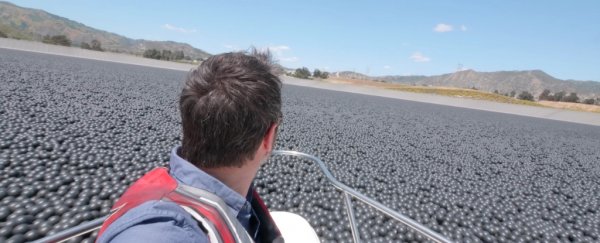Ninety-six million. That's how many black plastic 'shade balls' it takes to cover the Los Angeles reservoir. Why, you ask? Well, despite what has often been reported as the main purpose of these balls, the idea didn't actually start with just protecting the reservoir from evaporation.
In a new episode from Veritasium, Derek Muller investigates the story behind this wild idea.
"It looks absurd," Muller laughs in the video. "It's like we're in the world's biggest ball pit."
He's not wrong. Even from the middle of the reservoir, the boat where the presenter stands seems to be borne aloft not by the water below, but by the sea of spheres blanketing its surface.
Hiding below is some 12.5 billion litres of water (3.3 billion gallons), the same deposit where Muller's own drinking water comes from when he turns on the tap.

Yet despite their reputation for saving water, these balls were not put here just to reduce evaporation. The problem actually started with bromide, a natural substance found in salt water.
Bromide on its own is harmless to humans, but if some of this salty water creeps into the reservoir and undergoes ozone treatment with the rest of LA's drinking water, it can form the compound bromate. And bromate is a carcinogen.
The LA Department of Water and Power thought they were keeping tabs on these bromate levels, but for some reason, the carcinogen kept spiking when the water entered the reservoir. It turns out, when bromide and chlorine interact with sunlight, the reaction produces even more bromate than when the former interacts with ozone.
Originally called "bird balls", the solution was both odd and oddly perfect. Typically used around airports to stop birds from perching in nearby water, the black balls also turned out to be highly effective at keeping out sunlight.
"They knocked out the problem immediately," chief of LADWP Marty Adams told Muller in the video.
Adams also explains that their carbon black colour keeps each sphere working for up to ten years, with no toxic waste slipping into the water below. Even better, once these balls are placed on the reservoir, the treatment facility can use less chlorine for algae growth, which tends to thrive in sunlight.
And while evaporation was not the original reason these balls were used, they do in fact keep the water below much cooler.
"So for all of these reasons, shade balls reduce evaporation by 80 to 90 percent," Derek explains. "That's pretty significant for a dry climate like Los Angeles."
Between the savings in chlorination and evaporation alone, Adams says these balls will pay for at least half their original price, approximately a dollar per trio, by the time they are through with their task.
